This review page is supported in part by the sponsors whose ad banners are displayed below |
 |
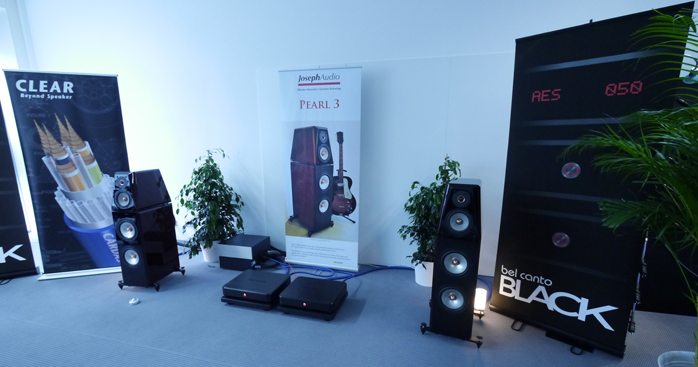 |
Back to b for blue (and black as it turns out), Bel Canto Design premiered their new three-box Black system. It consists of the C1 controller (all digital, analog inputs are digitized and the volume control set vertically into the top is of the 32-bit digital sort) and a pair of PMD1. Because this was my last room of my last day, I forgot to ask an important question. Are these really power DACs which convert incoming PCM into PWM to direct-drive the switching Ncore output stage with SMPS which John Stronczer explained is used only as buffer? Or are they instead two mono DACs + two analog switching mono amps with analog conversion between the two? The latter makes for an animal of very different stripes.
|
 |
Being last-minute prototypes still, I also don't know whether the current 24/192 limitation of the controller will remain in place when final production commences later in the year. In the absence of a BOM—bill of materials—pricing was still open too but expected to come in at ~$20.000 per box. The chosen speakers here were Joseph Audio Pearl 3.
|
 |
With Ncore OEMs expected to enter the market this year—Acoustic Imagery and Merrill Audio got there already, Bruno Putzeys said that Jeff Rowland was on the books—and Bruno's own Mola-Mola bowing, Bel Canto's decision to make theirs exclusively digital as far as inputs go isolates them from direct competition. Thinking of practical implications, my system relies on a 6-meter run of analog interconnects between the front-end stack and the amps. Would an equivalent digital link as required by this 'power DAC' be preferable, say AES/EBU or glass fiber?
|
 |
Here comes the business end of the controller. The case work for a change wasn't sourced from Neal Feay but a military subcontractor. With this product Bel Canto finally have their flagship gear which they couldn't execute with ICEpower. As John Stronczer explained, a surprisingly audible element is the reduction of jitter to apparently ludicrous levels. With three different USB bridges in their catalogue whose primary distinction is the quality of their clocks, John stated that the difference of more and more effective jitter reduction is plainly audible. This he credits to a concomitant reduction in noise floor. The clocks in the Black gear reduce jitter to femto second levels. Whilst cynics would call our ear/brain incapable of resolving down into these strata with endless zeros behind the decimal point, John was politely adamant. It is audible. He also expressed dislike of linear power supplies because their 50/60Hz noise can never be entirely banished. He prefers modern switch-mode supplies done right.
|
|
|
Devialet of France countered the ever escalating upwardly mobile price trend with three new models priced below their much reviewed and always loved Premier D. Under the tag line Eines Tages wird jeder einen Devialet haben (one day everyone will own a Devialet), the wily Gauls lowered their barrier of entry to €4.990. In the model 110 this doesn't buy you a reject or hand me down but simply a scaled-back core platform with lower power and less features yet identical tech.
|
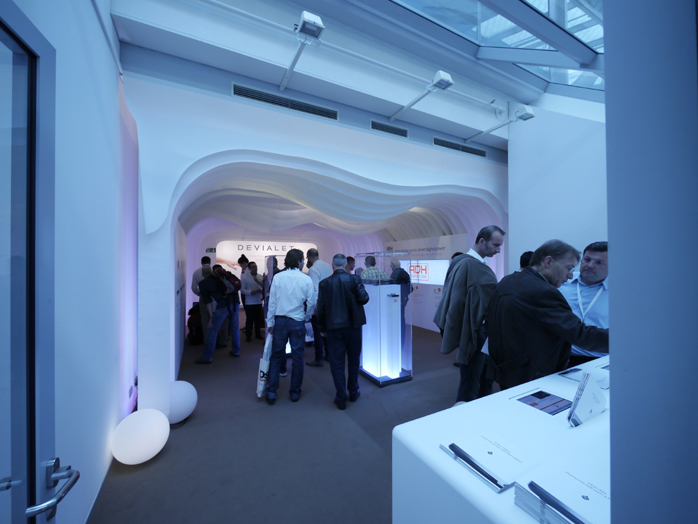 |
Starting at €6.990 there is the new 170 (the numerology equates to output power) and for €12.900 there's the 240. The entry-level models can be fitted with expansion modules. For €22.900 there's the bi-amping 500.
|
 |
In a futuristically styled display of one silver sliver of a do-it-all integrated amp atop a backlit blue podium playing a pair of Magico minis, the less-is-more minimalism implied even visually drove home the message. Hifi has gotten too complex. True technical innovation has been sacrificed at the altar of bling. Let's return to sanity and proper engineering.
|
 |
Here is the new baby Devialet - wifi streamer, Ethernet, configurable line input for MM, fully upgradeable via downloads to OS on memory card, boffo RF remote control and sonics like the mujo awarded big brother. Hola!
|
|
|
Telling me laughingly that his Gryphon brand had finally exited the dinosaur age for good—in a review I'd chided them for not supporting us computer hifi users—Flemming Rasmussen introduced his new €19.800 Kalliope USB DAC which runs on dual ESS Sabre 9018 32-bit brain juice. One eight-channel chip per side is configured dual differential and the undisclosed USB transceiver is not only good for 32/384 PCM but can track DSD up to 6.144MHz for which at present no software exists. That's underhanded for future proof.
|
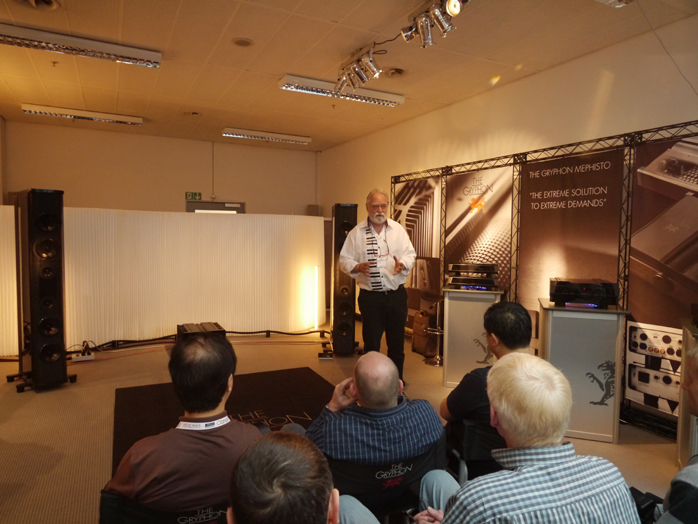 |
There are user-selectable PCM/DSD digital filters and equally selectable asynchronous SRC, temperature compensated ultra-low oscillators with <5ppm accuracy, galvanic isolation of computer and other digital sources, 1 x AES/EBU and 3 x BNC S/PDIF inputs plus a BNC input for an optional external word clock. Analog reconstruction filters are 1st-order for PCM, 2nd-order for DSD. Both use silvered Mica caps. The output stage is true class A, fully discrete and naturally sans NFB. Capacitance is 34,000μF per side and the 4-layer PCBs sport 70μm copper traces.
|
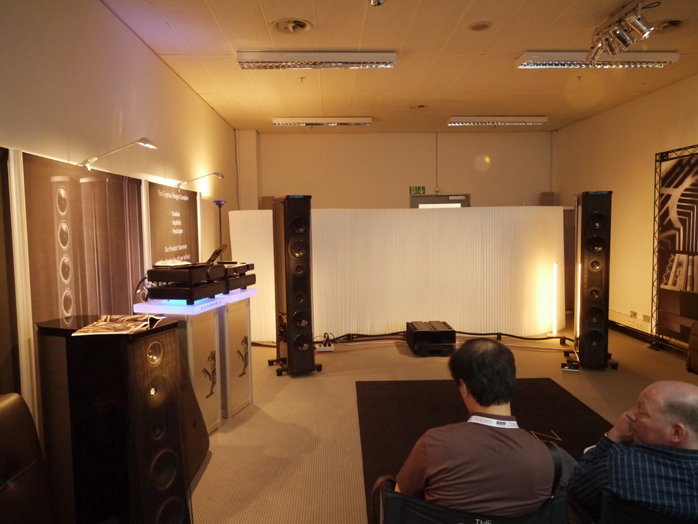 |
Of course inputs can be named and all manner of other bits adjusted in the clever touch-sensitive multi-layer menu. Here comes the Kalliope beneath the firm's Mikado Signature CD player which in the demo served three tracks as CD transport whilst a laptop streamer handled the final three. If the streaming data were in any way disadvantaged as the old guard keeps claiming in some quarters which staunchly uphold the superiority of optical playback, I didn't hear it.
|
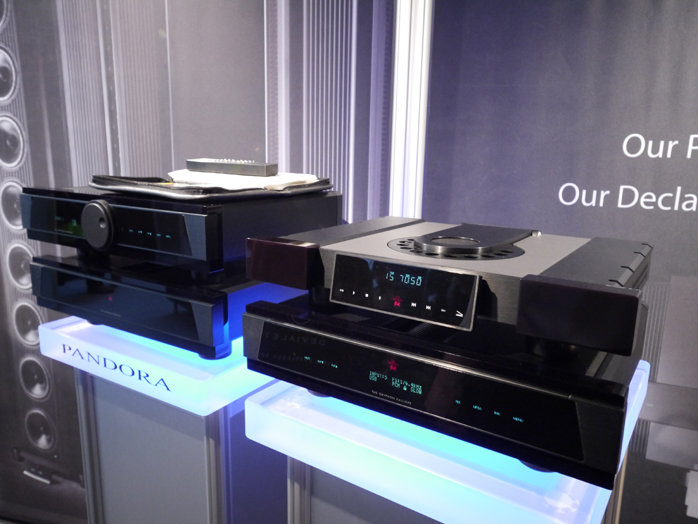 |
The speakers on demo were the €95.000/pr Trident II and the new Powerzone II 6 or 8 outlet AC distributors (€1.600) handled power delivery.
|
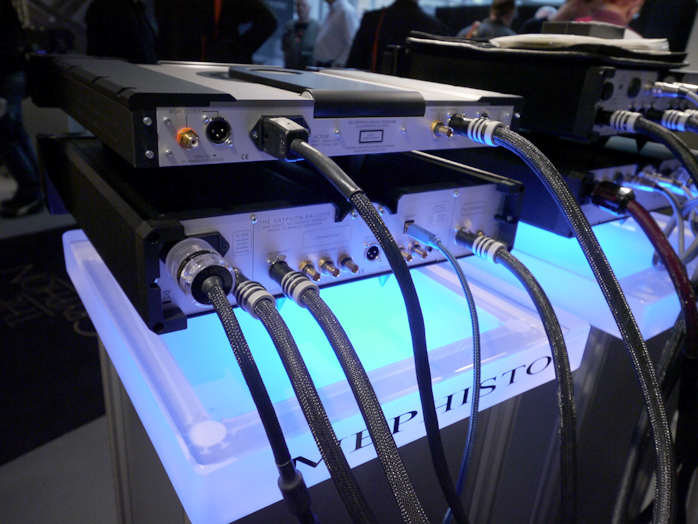 |
The first track Flemming played during his closed-room presentation was a killer bass clarinet number called "Two Hats" from the Denon disc Aurora. Since I'm allergic to taking notes, I took a photo to remember to hunt it down. Audiophile assassin on call.
|
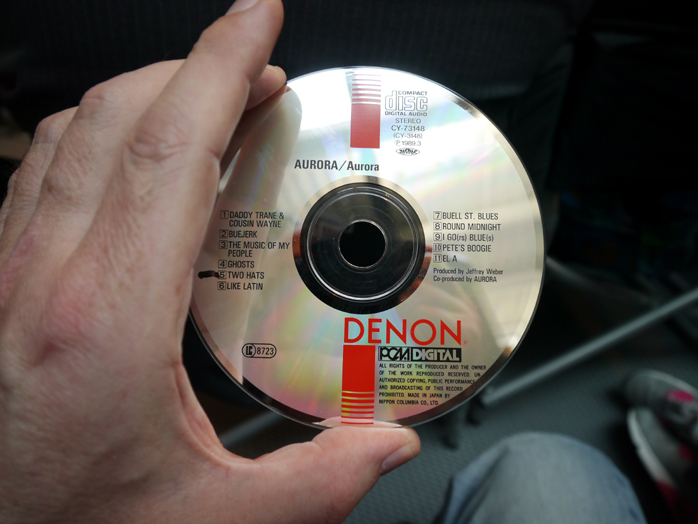 |
And here's a lovely anecdote. Waiting in line to enter the Gryphon room at the appointed time, I noticed a Korean lady taking photos of what I assumed was her Korean boss who held on firmly to a wheeled suitcase. I kidded her that they'd enter with an empty suitcase and leave the Gryphon room with it filled. She turned around and introduced herself as Christine Han, my old e-mail contact from April Music who'd since moved on to Damino, a Korean hifi import house. Next thing I knew the man opened his suitcase, withdrew a small box and handed it to me. Christine explained that it was a very special tea. As I found out whilst typing this report, it's very special indeed. Delivered as a concentrated liquid in 30g plastic sleeves, just add water and stir. It's a deliciously fruity honeyed affair. If it makes me live just one day longer than my allotted time, I'll owe it to the kindness of a stranger in Munich. Who says it's all about audio? Gracias!
|
 |
  |
 |